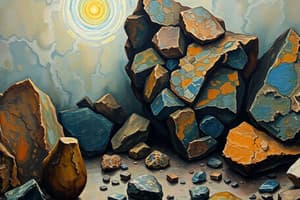Podcast
Questions and Answers
What primarily determines climate, according to the text?
What primarily determines climate, according to the text?
- Changes in Earth's orbit, tilt, and axis of rotation
- Atmosphere's temperature and moisture levels (correct)
- Sun's radiation
- Seasonal variations in weather patterns
How are ice ages primarily caused, based on the information provided?
How are ice ages primarily caused, based on the information provided?
- Variations in Earth's distance from the Sun
- Alterations in Earth's orbit, tilt, and axis of rotation (correct)
- Changes in atmospheric composition
- Shifts in the water cycle
Which layer plays a vital role in regulating the planet's climate and protecting life from the Sun’s radiation?
Which layer plays a vital role in regulating the planet's climate and protecting life from the Sun’s radiation?
- Stratosphere (correct)
- Mesosphere
- Troposphere
- Exosphere
What ended about 11,700 years ago, as mentioned in the text?
What ended about 11,700 years ago, as mentioned in the text?
Which of the following is NOT a component of Earth's atmosphere?
Which of the following is NOT a component of Earth's atmosphere?
What distinguishes weather from climate, based on the context provided?
What distinguishes weather from climate, based on the context provided?
What drives the water cycle process?
What drives the water cycle process?
Which component of an atom determines its properties?
Which component of an atom determines its properties?
Which atom has 8 protons?
Which atom has 8 protons?
In the water cycle, what happens when water vapor cools in the atmosphere?
In the water cycle, what happens when water vapor cools in the atmosphere?
What is the primary role of the water cycle in sustaining life on Earth?
What is the primary role of the water cycle in sustaining life on Earth?
How does the structure of an atom change when hydrogen and oxygen atoms bond to form water?
How does the structure of an atom change when hydrogen and oxygen atoms bond to form water?
Flashcards are hidden until you start studying
Study Notes
Earth Materials and Cycles
Our planet is a dynamic and interconnected system, governed by continuous cycles that shape the environment we inhabit. In this exploration, we'll delve into Earth's materials and cycles, specifically the water cycle, the structure of the atom, weather and climate, climate and ice ages, and the atmosphere and climate.
The Water Cycle
The water cycle is the continuous movement of water on, above, and below the Earth's surface. Sunlight drives this process through evaporation, which transforms water into water vapor that rises and gets cooled in the atmosphere, forming clouds. As these clouds encounter cooler temperatures, water droplets or ice crystals form, and precipitation occurs, returning water to Earth's surface. The water cycle never stops, and it's a vital component of sustaining life on Earth.
The Structure of the Atom
The water cycle is possible because of the chemical properties of water, which stems from the structure of the atom. An atom is the smallest unit of an element that can take part in a chemical reaction, and it's composed of a nucleus, containing protons and neutrons, and electrons, which orbit the nucleus. An atom's properties are determined by the number of protons it has, and hydrogen and oxygen, for example, have one and eight protons, respectively. When hydrogen and oxygen atoms form a molecule of water, their electrons bind together, creating a stable covalent bond.
Weather and Climate
Weather refers to the atmospheric conditions at a specific time and place; it describes things like temperature, wind, and precipitation. Climate, on the other hand, is the average of these conditions over a long period, usually decades or more. A variety of factors influence weather, but climate is primarily determined by the atmosphere's temperature and moisture levels, which are driven by Earth's energy balance, the Sun's radiation, and natural cycles like the water cycle.
Climate and Ice Ages
Ice ages are long-term cycles of cooling and warming that occur over thousands to millions of years. They're caused by changes in Earth's orbit, tilt, and axis of rotation, which affect the distribution of sunlight and, consequently, the planet's energy balance. During ice ages, large portions of Earth's land and oceans are covered in ice, leading to significant changes in climate, weather, and ecosystems. The last ice age ended about 11,700 years ago, and we're currently experiencing an interglacial period, or a warmer time.
Atmosphere and Climate
The atmosphere is a layer of gases, water, and other particles that surround Earth. It plays a vital role in regulating the planet's climate, protecting life from the Sun's radiation, and supporting the water cycle. The atmosphere consists primarily of nitrogen and oxygen, with smaller amounts of other gases, such as carbon dioxide, which contributes to the greenhouse effect and influences Earth's climate.
While it might seem complex, understanding the interconnectedness of these Earth materials and cycles is crucial for appreciating how our world functions. Further, these cycles provide insights into the natural patterns and processes that guide our climate and environment, informing our efforts to protect our planet and mitigate the impacts of climate change.
Studying That Suits You
Use AI to generate personalized quizzes and flashcards to suit your learning preferences.




